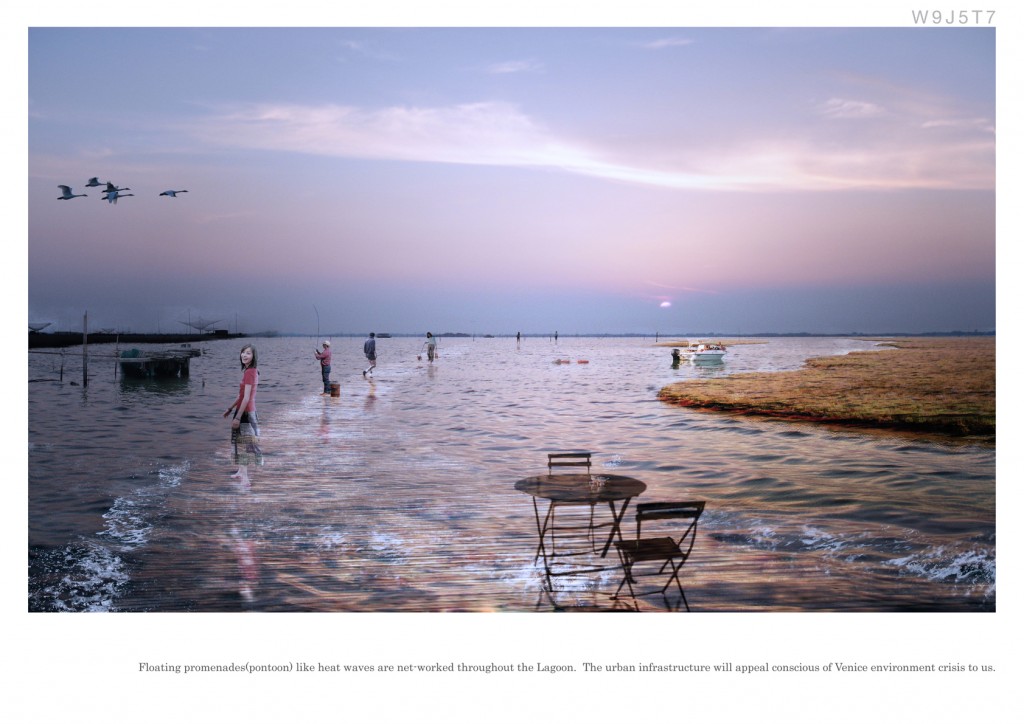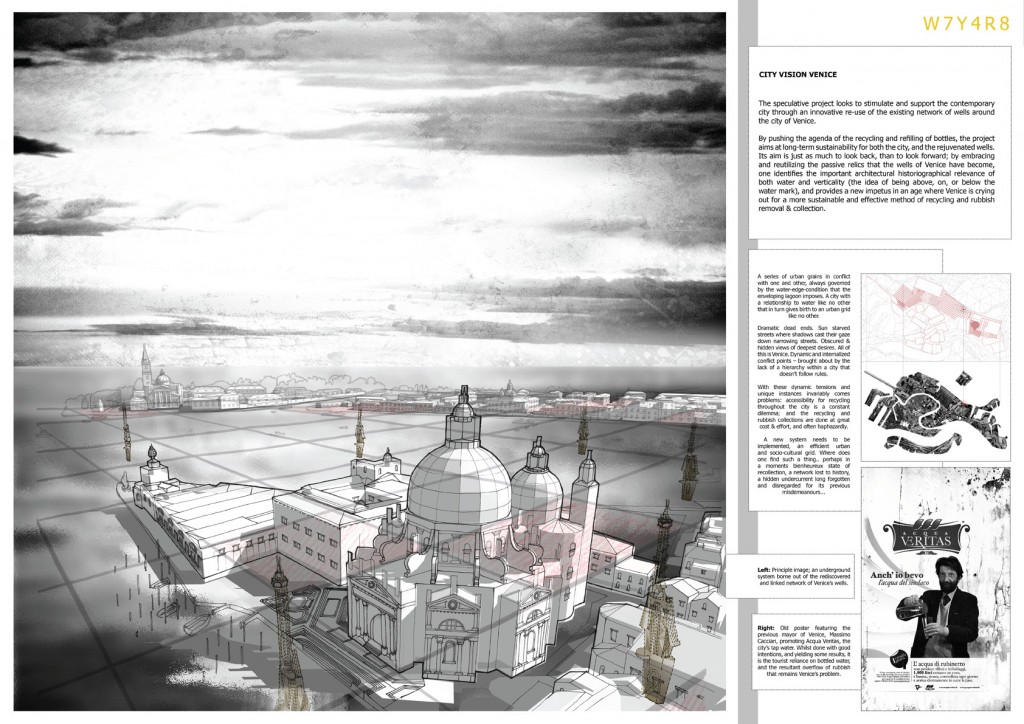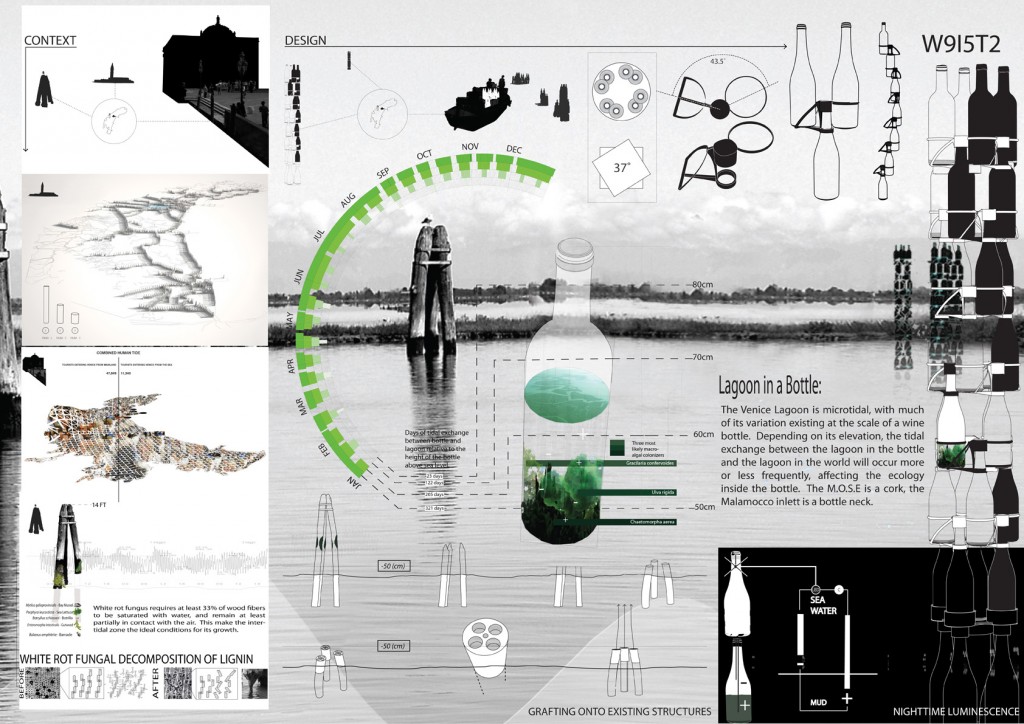Info:
Title: BRICOLE-AGE: lagoon in a bottle - Code: W9I5T2Contest: Venice / 2011
By: S. Denizen / J. Sieweke
Views: 3919 Likes: 0
Votes:
BJARKE INGELS10 NERI OXMAN6 ELENA MANFERDINI3 MARIA LUDOVICA TRAMONTIN5 BOSTJAN VUGA45.6
BRICOLE-AGE: lagoon in a bottle
Bricole-age takes the public infrastructure of channel markers in the Venetian Lagoon as its site. According to the Istituto Veneto, there are 6,768 channel markers in the Venetian Lagoon, each composed of at least three sixteen-foot oak posts about a foot in diameter. The exact number of these individual posts, called “bricola” (plural: bricole), is unknown but could be as many as 90,000. On average, these posts last only three years before they must be replaced at a cost to the city and municipality of over four million Euros per year. In a city that is already drowning in maintenance costs, this represents a significant problem. Existing proposals call for the replacement of the historic wooden bricole with plastic replicas, estimated to have a lifespan of at least 10 years. Rather than seeking to imitate how the bricole look, this proposal seeks to understand how the bricole work, as a starting point for generating a proposal. This requires an understanding of the material and cultural history of Venice and its lagoon, as well as the economic and ecological balance that has been so essential to the success of the city. Much like the city itself, it is at the intersection of these forces that we find the bricole.
This ecological and economic balance that has so defined the history of Venice is still the very central protagonist of its future. The terms of the equation have changed dramatically however. Venice is no longer a center of trade, no longer a naval power, and no longer a serene republic. It’s primary import is a staggering 60,000 people per day, more than the total residential population of the city, who then leave in a mass exodus with the last trains departure. Much like in the lagoon itself however, it is the intertidal zone that is the most rich in nutrients, and if this is a human tide, Venice is the intertidal zone. If the city is to survive the 21st century, it must find a way to allocate these resources efficiently.
The problem is also a cultural one however. These 60,000 people are mostly tourists, who rarely are offered the opportunity to understand the city’s relationship to its waters, and are therefore unable to participate in the preservation of the city. Understanding that the lagoon is not merely the backdrop to a beautiful city, but the very thing that makes the city possible on a daily basis, is an understanding that carries an ethical potential for the primary users and consumers of its resources. What if this ethical responsibility for the care of the city was extended to tourists? This is the question that will be tested in the case of the bricole.
Bricole-age proposes to build the bricole out of a modular system glass wine bottles. Glass is the most inert material in abundance on the planet. It is not subject to the fungal rot that attacks the oak bricole at its intertidal zone. Between the two-to-six cruise ships per day which dock at Venice, and the thousands of bars and restaurants that serve our 60,000 tourists, there is a steady supply of glass wine bottles immediately available for use. Due to the difficulty of managing the waste stream in a city without wide streets in between every home and business, these glass bottles are not recycled, but are instead shipped to the waste incinerator at Porto Marghera.
The design of this modular system further draws upon the chemistry and ecology the oak bricole, in order to produce a new relation to the ecology of the lagoon. The modular stacking system generates an incremental increase in the height of the bottle openings, allowing them to fill with the rising of the tide. Once full each bottle becomes a lagoon in miniature – a microcosm of the dynamics of tidal exchange through narrow pre-existing inlets which drive the ecology of the lagoon as a whole. Very quickly these bottles will fill with the slimy and bristly photosynthetic life of the intertidal zone, forming a muck of oozing life. This is the lagoon at its best, and in this sense it was always the rotting of the bricole that provided the most visceral evidence that the lagoon was not dead, but very much alive. These wine bottles will not replace the bricole with a fiction of immortality, but rather more evidence of the permanence of the process of life and death in the lagoon.
The chemistry of the rotting of the oak bricole will also be re-appropriated in the design of the glass bottle bricole. The microbial and fungal decomposition of lignin and cellulose requires the production of free radicals for the oxidation reactions that are required. This process of chemical oxidation is fundamental to the decomposition of organic matter, and as these molecules are being ripped and torn apart, free electrons are produced. Microbial fuel cells are a technology recently developed to harness the production of these free electrons for the generation of electricity. These fuel cells were recently tested in the Venetian lagoon by two students at the Worcester Polytechnic Institute, and generated a potential of 0.35 volts simply from the ongoing process of organic decomposition in the lagoon muck. This is the same process that would be ongoing in the intertidal zone of the glass bottle bricole, and could therefore be implemented at a low cost to light the bricole in energy efficient LED’s. The pulsing of this dim light along Venice’s channels at night would give further expression to the vitality of the lagoon and its important ecological processes.
The act of setting out these wine bottles in the campo (public square in Venice) for delivery to the channels by barges creates a kind of urban ritual. The stacking of the bottles, in various configurations, is a task that tourists would be charged with completing. The presence of these baby bricole in every campo also serves as a constant reminder of the supporting infrastructure that lies just beyond the glass of wine they hold in their hand, but at a scale that relates directly to that glass of wine. The tourists become implicated, and in some small measure, offered an ethical engagement with the place they are in.
Info:
Title: BRICOLE-AGE: lagoon in a bottle
Time: 6 giugno 2011
Category: Venice
Views: 3919 Likes: 0
Tags: Adriatic Sea , Denizen , Glass bottle , Intertidal zone , Sieweke , Venetian Lagoon , Veneto , Venice , Wine bottle , Worcester Polytechnic Institute









